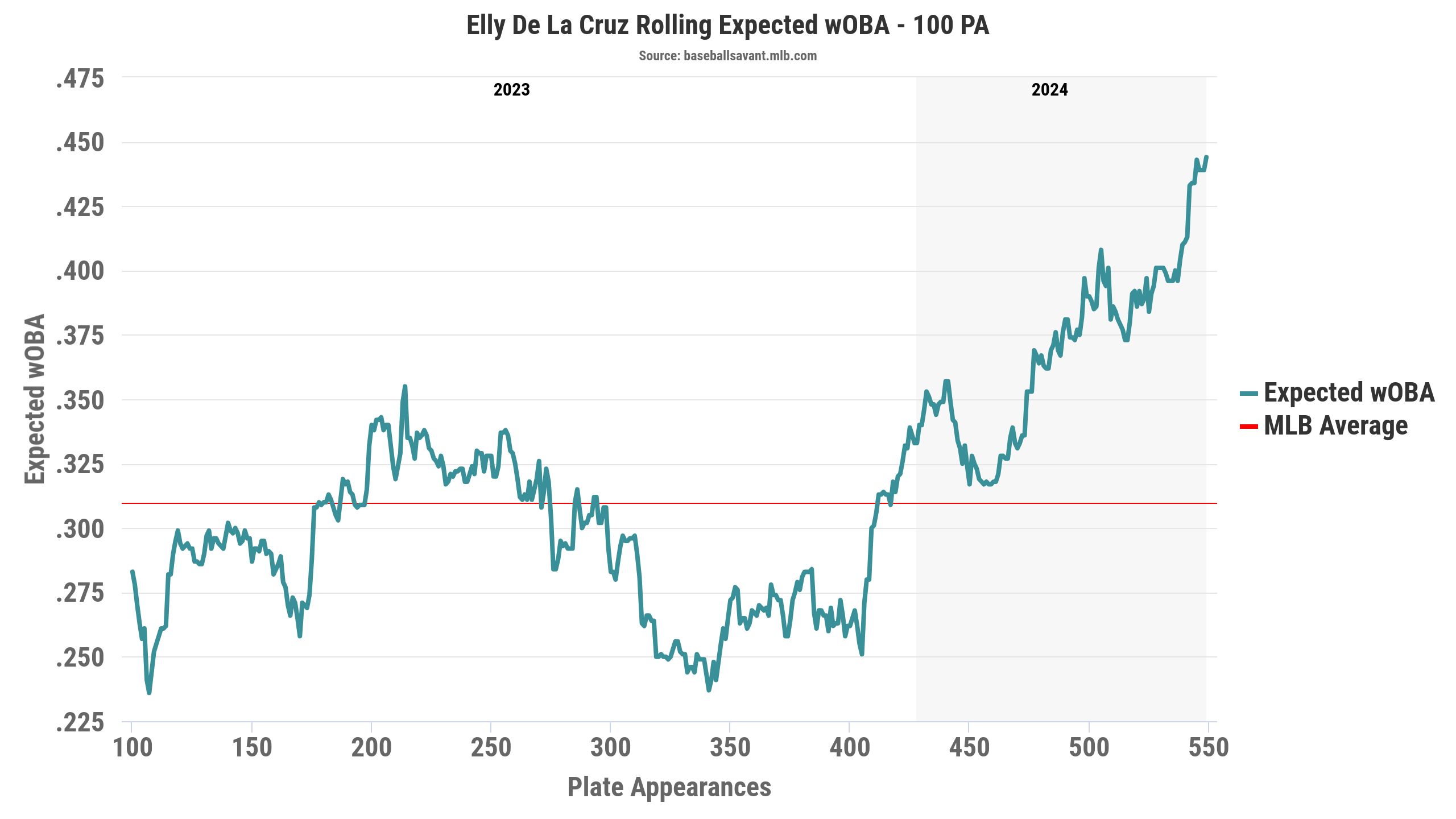One year after the Braves’ Ronald Acuña Jr. became the first player in MLB history to produce 40-plus homers and 70-plus steals in a season, the Reds’ Elly De La Cruz is threatening to form a club of his own: the 40-90 Club.
Cincinnati’s budding superstar is off to a historic start -- he finished April with eight homers and 18 steals, becoming the first player on record to hit both of those marks in any calendar month.
De La Cruz is currently on pace to end 2024 with an almost unfathomable 42 homers and 94 stolen bases. He’s slashing .280/.389/.579 (171 OPS+) to boot.
The 22-year-old was an obvious breakout candidate entering this season, but it was hard to imagine he’d be this good, this quickly.
De La Cruz flashed electric raw tools as a rookie in 2023, recording some of MLB’s hardest-hit batted balls and fastest individual runs, as well as the fastest assist by an infielder under Statcast tracking (since 2015).
However, his offensive production didn’t fully align with the skill set. Over 98 games with the Reds, he hit .235 with 13 homers, 35 steals and a .710 OPS (89 OPS+), striking out 144 times in 427 plate appearances.
And yet, just a month into his sophomore campaign, De La Cruz has us believing that he might be able to go where only Acuña has gone before -- and possibly even further -- in the realm of baseball’s greatest power-speed combo seasons.
Before the Reds begin an intriguing series against the Orioles on Friday, let’s take a look at the improvements the youngster has made, both at the plate and on the bases, so far in 2024. (All stats below are through Wednesday.)
How he’s improved as a hitter
De La Cruz’s breakout at the plate has been driven, in part, by the switch-hitting slugger making dramatic strides in three key areas.
1. Laying off bad pitches
Like many young hitters trying to adjust to the highest level of professional baseball, De La Cruz was undisciplined in his approach last season, ranking in the 24th percentile with a 32.8% chase rate.
This year, his chase rate is down to 27.5%, which places him in the 48th percentile. Accordingly, his walk rate has spiked from 8.2% to 13.5%, tied for the 10th-largest jump (+5.3 points) in MLB.
De La Cruz has had a particularly large drop in chase rate (from 36.9% to 27.9%) in the two lowest zones -- the types of pitches most likely to be hit on the ground when a batter makes contact -- which is likely one of the reasons he is hitting for more power this season.
2. Demolishing hittable pitches
While De La Cruz has shown more discipline against bad pitches, he has been more aggressive attacking the most hittable offerings and is doing far more damage on them compared to 2023.
De La Cruz has increased his swing rate on pitches in the heart of the zone (defined as pitches that are more than a baseball's width inside the strike zone) to 69.5% and is slugging .923 -- the highest in MLB (minimum 50 PAs) -- on those pitches. Seven of his eight homers have come on pitches thrown in the heart of the plate.
Highest SLG on pitches in the heart of the zone, 2024
Minimum 50 PAs ending on those pitches
- Elly De La Cruz: .923
- Mike Trout: .860
- Mookie Betts: .855
- Gunnar Henderson: .810
- Alec Bohm: .768
Last year, his swing rate on pitches in the heart of the zone was 66.4%, and he slugged .574 against them.
The difference has been even more stark on pitches classified as “meatballs” (true middle-middle pitches in the zone). Against these pitches, De La Cruz has bumped his swing rate from 69.4% to 84.6% and his slugging percentage from .432 to 1.231.
3. Hitting the ball in the air with more authority
De La Cruz’s ground-ball rate is still fairly high at 52.9%, but he has been squeezing more value out of his fly balls and line drives by hitting those balls harder, on average, than he did a year ago. De La Cruz’s average exit velocity on balls in the air has jumped from 95.2 mph to 99.7 mph year over year.
Overall, nearly 30% of his batted balls this season have been both hard-hit (95+ mph exit velocity) and hit in the launch angle sweet-spot zone (from 8-32 degrees), up from just 16.3% in 2023.
Only five hitters (minimum 50 batted balls) have done that more frequently in 2024.
Highest hard-hit + sweet-spot rate, 2024
Minimum 50 batted balls
- Shohei Ohtani: 33.3%
- Adolis García: 32.5%
- Brandon Marsh: 32.3%
- Marcell Ozuna: 30.2%
- Will Benson: 29.5%
- Elly De La Cruz: 29.4%
Not surprisingly, this has also led to more barrels -- batted balls with the optimal combination of exit velocity and launch angle, typically resulting in extra-base hits -- for De La Cruz, whose barrel rate has gone from 8.5% to 17.6% (MLB's second-largest increase from 2023 to 2024).
Add it all up and De La Cruz's expected wOBA -- a Statcast metric that takes quality of contact, strikeouts and walks into account -- has skyrocketed from .303 (20th percentile) to .403 (95th percentile).
While 126 plate appearances isn't exactly a large sample size, it's still meaningful for making a comparison to his rookie season. As the chart below shows, he never came remotely close to performing this well over any stretch of 100 plate appearances as a rookie.

How he’s improved as a base-stealer
De La Cruz is one of the fastest players in the Majors, but raw speed isn’t the only reason he’s currently on pace to become the first player since Rickey Henderson in 1988 to steal at least 90 bases in a season.
His increased on-base percentage also hasn’t had as much of an impact as you might think -- he’s actually averaging slightly fewer opportunities (defined as plate appearances where a runner was on first or second with an open base in front of them) per game than he did last year.
De La Cruz, though, has been taking off far more often than he did in 2023. His percentage of steal attempts per opportunities has risen from 40.6% (43 attempts, 106 opportunities) in 2023 to 67.7% (21 attempts, 31 opportunities).
Amazingly, he has managed to increase his efficiency as well, going from an 81% success rate to 86%. How? By getting better jumps, which has made it even harder for opposing catchers to stop him.
The speedster has increased his average primary lead distance on steal attempts from 11.8 feet to 13.5 feet, while his average secondary lead distance, which reflects the jump a baserunner has gotten by the time the pitcher releases the pitch, has gone from 20.3 feet to 22.8 feet. That might not seem like a lot, but the difference between a successful steal attempt and a failed one is typically a matter of inches.
What's next?
The amazing thing is, De La Cruz isn’t yet a finished product. Not even close. He’s only 22 years old, with fewer than 130 career games under his belt, and he’s doing all of this despite striking out 31% of the time and hitting the ball on the ground significantly more than the average player.
Somehow, he still has a lot of room to grow. We'd say the sky's the limit, but that might be selling him short.
